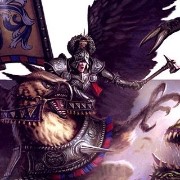|
So, by my count there were three foreign interventions that prolonged the Thirty Years' War after the Catholics had it won, but how many times could the conflict have ended with one side's victory before some foreign or local muckety–muck decided to get involved? Also, what would :HRE: look like? Arbite fucked around with this message at 13:03 on Sep 20, 2016 |
|
|
|

|
| # ? May 12, 2024 15:02 |
|
14 Tanks: We must secure the existence of our vehicles and a future for Wunder Waffen?
|
|
|
|
Arbite posted:So, by my count there were three foreign interventions that prolonged the 30 years war after the Catholics had it won, but how many times could the conflict have ended with one side's victory before some foreign or local muckety–muck decided to get involved? It basically was completely won until the emperor pissed it all away in 1629 with the edict of restitution. Arbite posted:Also, what would :HRE: look like? Glorious
|
|
|
|
P-Mack posted:It basically was completely won until the emperor pissed it all away in 1629 with the edict of restitution. did he listen? nooooo
|
|
|
|
feedmegin posted:Hmm. The US built up to the second strongest naval power in terms of battle line strength in the twenty years after 1886' - what, including the High Seas Fleet?! It makes sense, assuming the HSF didnt really get going until after the Royal Navy obsoleted itself with the Dreadnought in 1906.
|
|
|
|
Arbite posted:Also, what would :HRE: look like? 
|
|
|
|
feedmegin posted:Hmm. The US built up to the second strongest naval power in terms of battle line strength in the twenty years after 1886' - what, including the High Seas Fleet?! Yep. The US built a ton of predreads. Three Indianas, an Iowa, two Kearsarges, some Maines, five Virginias, and another class or two. Meanwhile Tirpitz's beard and Willy's arm hadn't quite taken over German policy quite yet. In 1906 the US had a lot of battleships. They fell behind in numbers after but that's more Germany building a lot than the US not building many, and I'd have to look up when each nation had how many.
|
|
|
|
tokenbrownguy posted:Bring back minechat. Best part of the new thread. Why not both? 
|
|
|
|
Arbite posted:Also, what would :HRE: look like? 
|
|
|
|
It is absolutely mind blowing to me that humans were able to build things like dreadnoughts or Titanic using slide rules and pencils and Irishmen. Like, I can barely make a chicken coop, and they were able to bend forty of fifty tons of steel into things that actually worked as intended much of the time. Maybe it just because I don't know much about naval engineering in general but that stuff has always seemed like borderline black magic to me.
|
|
|
|
bewbies posted:It is absolutely mind blowing to me that humans were able to build things like dreadnoughts or Titanic using slide rules and pencils and Irishmen. Like, I can barely make a chicken coop, and they were able to bend forty of fifty tons of steel into things that actually worked as intended much of the time. Engineering drawings from the 19th century are incredible. Not just hand drawn, but also super detailed compared to today's. Trade off is now I can CAD up in ten minutes what used to take half a day.
|
|
|
|
I really want to meet the guys who designed mechanical fire control computers. I can't even look at the plans without feeling like I'm stareing at the necronomicon , I can't even imagine thinking one up
|
|
|
|
They're just utterly ingenious mechanisms designed to mechanically perform complicated calculus in real time on a pitching, shaking warship, and if you could make it maintainable in the field and as small as possible that'd be great thanks. They're still in the "link to navweaps and pretend I understand" region for me. Also I think I'll post what I'm doing in here rather than link because these threads tend to get gold mined. bewbies posted:It is absolutely mind blowing to me that humans were able to build things like dreadnoughts or Titanic using slide rules and pencils and Irishmen. Like, I can barely make a chicken coop, and they were able to bend forty of fifty tons of steel into things that actually worked as intended much of the time. It's nuts to me too. It makes sense how ship design was done by major institutions though (there are a whole bunch of junior designers for every senior one, whose job is basically to keep them from messing up too much). There's also a ton of calculation, you'll get some major design changes when it turns out that one way of doing things saves a bit of weight (such as the idea for "knuckled" armor on the South Dakotas, which lost out by a pretty small margin to a more normal belt that sloped outward all the way up, rather than coming back in near the top). There's a fun article on navweaps about the institutional environment for German ship design in WWI and WWII, as well as the one I linked in the first post about the NC about ship design. xthetenth fucked around with this message at 15:42 on Sep 20, 2016 |
|
|
|
You're also probably looking at outboard diagrams and assembly sheets. Most large structures are designed and built by component and assembled to a point in the superstructure. It makes it a lot simpler to read when you know that screw shaft is part of the engine assembly which is part of the powerplant assembly which goes there according to the print. Also a lot of those outboard prints were traced from assembly drawings using shadow projection. Source: drafting classes I took in high school.
|
|
|
|
Random Number posted:You're also probably looking at outboard diagrams and assembly sheets. Most large structures are designed and built by component and assembled to a point in the superstructure. Most of what you see are so called spring styles, which are pretty much the design equivalent of the math professor going "and the rest is trivial". Trivial yes, but a ton of work. Once you know the layout of the big ticket items, there's a lot of doing detail design and shifting things around so the weight of a bit of ship roughly matches its bouyancy so you don't get huge stress concentrations. And that's after you figure out how many of which guns go where with how much machinery laid out how and behind how much armor, which can sometimes take a withering number of options evaluated before a settlement is reached (in the fifties for the NC class).
|
|
|
|
HEY GAL posted:hapsburgs and popes traditionally bury their organs seperately. in the case of the popes, this is done in small jars. they do it to keep their phylacteries safe
|
|
|
|
Though my lot didn't use mechanical computers or build ships or anything like that, I'm still astounded at some of the feats of sheer organisational detail that are utterly baffling to me, a 21st century tech-savvy guy frustrated in the extreme by the fact I can't manage to sync up my google calendar to my work calendar, and even if I could am utterly disorganised anyway. No Conscription Fellowship key members Catherine Marshall and Joan Beauchamp kept detailed records of 18,000 men, a network of thousands of contacts, the full workings of an underground distribution system for a heavily persecuted newspaper organised in cells where prosecution wouldn't bring down the whole structure and still allow for flexible work no matter the predations of the police or the Defence of the Realm Act, and ran an effective pressure network operating at the highest echelons of British politics, all from a small office in London. In triplicate. While printing a newspaper weekly. On and hand press. And moving the records from location to location. And evading constant surveillance and harassment raids. On filing cards. Tiny little cards. And then they were all destroyed and/or lost, which is a bugger The administrative logistics of the world wars, all those papers and typewriters and pen pushers and rear echelon people that don't seem to be doing much at all, summoned up from civilian life as and when needed and put into place comparatively blisteringly quickly -getting all that working right even a fraction of a time is as incredible an achievement of the human organism, our little brains built to hunt gazelle and outsmart each other in the process, as any feat of engineering.
|
|
|
|
For me, it's some of aviation's achievements in the mid-20th century that still astound me. The Valkyrie and Blackbird would be really interesting planes if they were revealed today, but they're creeping towards being half a century old if not there already.
|
|
|
|
now imagine all of that by hand, in the middle of a 17th century army camp
|
|
|
|
HEY GAL posted:now imagine all of that by hand, in the middle of a 17th century army camp I'm pretty sure a Blackbird could render a 17th century army combat ineffective just by doing a few low passes at full power overhead.
|
|
|
|
bewbies posted:It is absolutely mind blowing to me that humans were able to build things like dreadnoughts or Titanic using slide rules and pencils and Irishmen. Like, I can barely make a chicken coop, and they were able to bend forty of fifty tons of steel into things that actually worked as intended much of the time. I feel the same way about using electricity and gyroscopes to create remote bomber turrets. Also, the construction of the R100: On calculating the structure: quote:" The stress calculations for each transverse frame, for instance, required a laborious mathematical computation by a pair of calculators that lasted for two or three months before a satisfactory and true solution to the forces could be guerntted. [...] Each transverse frame consisted of a girder in the form of a stiff, sixteen-sided polygon with the flats at the top and bottom; this girder was twenty-seven inches deep and up to a hundred and thirty feet in diameter. Sixteen steel cables ran from the center of the polygon, the axis of the ship, to the corner points, bracing the polygonal girder against deflections. All loads, whether of gas lift, weights carried on the frame, or shear wire reactions, were applied to corner points of the polygon, and except in the case of the ship turning these loads were symmetrical port and starboard. One half of the transverse frame, therefore, divided by a vertical plane passing through the axis of the ship, consisted of a encastre arched rib with ends free to slide toward each other, and this arched rib was braced by eight radial wires, some which would go slack through the deflection of the arched rib under the applied loads. Normally four or five wires would remain in tension, and for the first time approximation the slack wires could be guessed. The forces and bending movements in the members could be calculated by the solution of a lengthy simultaneous equation containing up to seven unknown quantities; this work usually occupied two calculators about a week, using a Fuller slide rule and working in pairs to check for arithmetical mistakes. In the solution it was usual to fine a compression force in one or two of the radial wires; the whole process then had to be begun again using a different selection of wires.
|
|
|
|
Cythereal posted:I'm pretty sure a Blackbird could render a 17th century army combat ineffective just by doing a few low passes at full power overhead. You think that the pre-mediatisation HRE is complicated now? Wait till a rain of hydrogen bombs breaks it up into a series of political entities you need an electron microscope to see.
|
|
|
|
You're forgetting the battle wizards. And then your pilots get the day off and are immediately subsumed into the alcohol/pistols/windows cloud
|
|
|
|
Agean90 posted:I really want to meet the guys who designed mechanical fire control computers. I can't even look at the plans without feeling like I'm stareing at the necronomicon , I can't even imagine thinking one up https://www.youtube.com/watch?v=s1i-dnAH9Y4 Watch this US navy training film, it does a fairly interesting job of explaining the inner mechanics.
|
|
|
|
if wallenstein was immune to being shot, does a missile still count as a "bullet" for the purposes of the magic
|
|
|
|
HEY GAL posted:if wallenstein was immune to being shot, does a missile still count as a "bullet" for the purposes of the magic Did his protection extend to rockets? Would your guys have been familiar with them? I know about Congreave in the 19th century, but I have a super vague recollection of maybe some Swedish guy writing one of those ridiculously named treatise on rocket artillery in the 17th?
|
|
|
|
lenoon posted:Did his protection extend to rockets? Would your guys have been familiar with them? I know about Congreave in the 19th century, but I have a super vague recollection of maybe some Swedish guy writing one of those ridiculously named treatise on rocket artillery in the 17th? flares and grenade launchers are a thing. i do not know about rockets yet
|
|
|
|
HEY GAL posted:if wallenstein was immune to being shot, does a missile still count as a "bullet" for the purposes of the magic What if it has silver components?
|
|
|
|
PittTheElder posted:What if it has silver components? Then your own soldiers would buy alcohol with it.
|
|
|
|
just bless it, it's what the guys who actually killed him did
|
|
|
|
lenoon posted:You're forgetting the battle wizards. And then your pilots get the day off and are immediately subsumed into the alcohol/pistols/windows cloud How is this different from pilots now?
|
|
|
|
HEY GAL posted:flares and grenade launchers are a thing. i do not know about rockets yet Didn't the Mongols use rudimentary rockets that they brought over from China? I have never looked into it but I assumed they were being used by the 1600s
|
|
|
|
Ensign Expendable posted:How is this different from pilots now? Pretend I transcribed the bit about Hornet's air wing getting back to Pearl and getting crushed to the point where their torpedo squadron's commander fired a whole magazine out the door of their barracks.
|
|
|
|
The tradition of HEY GAL's people lives on.
|
|
|
|
With the talk about mechanical fire control i thought id try to outline a basic part of how one works by using a targetting problem to illustrate. (Maths ahead, i apologise if it feels patronising, i tried to keep it as accessible as possible) Using a MFC required first an observer making an estimate of: 1: Range 2: Bearing 3: Speed 2 and 3 together make up a ships course. Start a plot involves feeding these numbers that into the MFCC, the MFCC will then operate to output the position of the enemy ship as time passes. It is the enemy range at this point in time, and the ability to calculate what his range will be after a given time, by using his bearing and speed and a given time, (say the flight time of your shells for instance). A ships course and speed is a vector, a vector is something that has both direction (course) and magnitude (speed), a vector can be split into components, essentially just as 5 can be split into 1 + 4, Vx can be split into V1+V2, with the addition of angle E we have what is called a vector triangle, trigonometry allows us to work out vector Vx.  So here we have two ships with two courses and two speeds, which are represented by two vector triangles, (bottom left, top right).  In this diagram R = Line of sight between the two ships Vo = Course and Speed of own ship Vop = Vector of own ship perpendicular to the LOS between the ships Vor = Vector of own ship paralell to LOS between ships. N = Angle of line of sight from the course of own ship Ve = Course and Speed of enemy ship Vep = Vector of enemy ship perpendicular to the LOS between the ships Ver = Vector of enemy ship paralell to LOS between ships. M = Angle of line of sight from the course of the enemy ship# To get a complete expression for an enemy ships position in time we need to consider 3 things: Range rate, which is the rate of change of the range. (A speed). Or how much the range will change over a given period of time. Bearing Rate, which is the rate of change of the bearing, or angle, between the two ships. (A speed). Or how much the angle between your ships will change in a given time. These two can be combined to produce: Rate of Change of the Range Rate. (An acceleration). Or how the Range rate will vary over a given period of time. Range Rate Vr = Velocity of the enemy ship along the line R (The LOS line) Ver and Vor are parallel as they both lie along line R, hence Vep and Vop are paralell as they both are perpendicular to that line. Range at a point in time after the start of the plot consists of: Observed Range + (Range Rate x Time), where range rate can be derived from that vector diagram. As Vor and Ver are are paralell this is: Ver + Vor = Range Rate. Ver and Vor are both derived from the Vector of each ship, looking back at the first vector triangle picture. V1 = Cos (E) x Vx V2 = Sin (E) x Vx By using Cos and Sin and the observed quantites of: bearing E and speed Vx we can calculate these two quantities. Hence, to get the quantity Range Rate it becomes: (Ve x Cos (N)) + (Vo x Cos (M)) = Range Rate. (RR) And from the observed quantities of Bearings N and M and speecs Ve and Vo we get RR. Bearing Rate Vp = Velocity perpendicular to the LOS line. Bearing rate is a combination of Ver and Vor in exactly the same way as Range Rate. Hence. Bearing Rate = (Ve x Sin(N)) + (Vo x Sin (M)) And from the observed quantities of Bearings N and M and speeds Ve and Vo we get BR. Rate of Change of Range Rate. Differentiation is a mathematical process, if you differentiate a speed you get an acceleration,. Im not going to write out the proces for differentiation as it would get long and hard to follow without the ability to use technical notation. The differentiation relies on the two courses remaining unchanged. But if you differentiate RR and you get: (Ve x Sin (N)) + (Vo x Sin (M)) x Bearing Rate = Rate of Change of Range Rate (RCRR) Putting it all together.  So if a ship fires at T = 0 it needs to know 2 things at T = Impact. 1: Bearing of Enemy Ship 2: Range of Enemy Ship It has an Initial bearing (M), range (R) and speed (Ve), for the enemy ship from observation. It also has its own speed (Vo) and bearing (N) from the ships instruments. It also knows the flight time of its shells for a given range. From the enemy ships range you can derive a flight time of the shells, and using the BR, RR and RCRR formulas you can work out where the enemy ship will be at the end of that time period. (Ve x Cos (N)) + (Vo x Cos (M)) = Range Rate (Ve x Sin(N)) + (Vo x Sin (M)) = Bearing Rate (Ve x Sin (N)) + (Vo x Sin (M)) x Bearing Rate = Change of Range Rate Range at time of Impact = Initial observed range + (RR x time) + (RCRR x time^2) Bearing at time of impact = Initial observed bearing + BR x time Hence you now have a direction and a range to shoot that you can derive from data from your observers. A mechanical firing computer automates all those calculations and generates a constant solution from the data you put in and means that at any point you can get those solutions, the actual way it combines them is explained the US navy training video i linked earlier, each operation is a seperate mechanical component chained together to get you from Input to Output.
|
|
|
|
The math and theory I get, it's the actually implementing it all mechanically that blows my mind.
|
|
|
|
P-Mack posted:The math and theory I get, it's the actually implementing it all mechanically that blows my mind.
|
|
|
|
The fact that there are infinitely adjustable gear ratios inside them is probably the coolest part to my mind, the idea of that is just so neat.
|
|
|
|
P-Mack posted:The math and theory I get, it's the actually implementing it all mechanically that blows my mind. so many gears holy gently caress how do they keep them all straight
|
|
|
|

|
| # ? May 12, 2024 15:02 |
|
Polyakov posted:With the talk about mechanical fire control i thought id try to outline a basic part of how one works by using a targetting problem to illustrate. (Maths ahead, i apologise if it feels patronising, i tried to keep it as accessible as possible)
|
|
|




























 Yes, it's like a lava lamp.
Yes, it's like a lava lamp.





